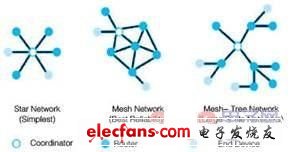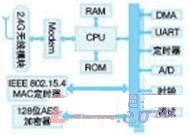1 Introduction
The wireless sensor network based on zigbee technology is suitable for occasions with many outlets, small size, small data volume, reliable transmission, and low power consumption. It has gained a place in the fields of environmental monitoring, wireless meter reading, intelligent community, industrial control, etc. [1]. At the same time, zigbee norms and agreements are improving [2]. From zigbee1.0, zigbee1.1 to the latest zigbee2007 / pro, the evolution of the zigbee protocol specification puts forward higher requirements on the hardware system [3].
2 Design requirements
2.1 zigbee network structure
From the perspective of the network structure, the zigbee network has three modes: star, tree, and mesh. According to the function of the network node, it can be divided into three types: terminal node (ep), router node (rp), and coordinator node (cp) [ 2]. Its organizational structure is shown in Figure 1.

Figure 1 zigbee network topology
Among them, the coordinator node is responsible for initiating and maintaining a wireless network, identifying the devices in the network to join the network; the router node supports the network link structure and completes the forwarding of data packets; the terminal node is the network ’s perceiver and executor, responsible for data collection and Executable network actions [2]. This requires the zigbee network node to play three roles: terminal awareness, network supporter, and network coordinator.
Functionally, the zigbee node should be composed of a microcontroller module, a memory, a wireless transceiver module, a power module, and other peripheral function modules. Its structure is shown in Figure 2.

Figure 2 zigbee network node module diagram
Among them, rich peripheral functions including dma, usart module, timer module, a / d module to meet the network's demand for hardware resources, the memory module completes the storage and execution of the protocol stack, and the CPU implements data calculation and processing , Mac timer is used to achieve network synchronization, use aes technology to encrypt information, the wireless module completes receipt and transmission of receipts and information frame control.
2.2 Zigbee network node design requirements
(1) Available wireless frequency bands. The choice of wireless frequency band should have both higher transmission rate and better diffraction performance, and at the same time must have certain anti-interference ability. The 2.4ghz frequency band is one of the two working frequency bands defined by ieee 502.15.4 and working in the ism frequency band. There are 16 channels with a rate of 250 kb / s.
(2) Small size, low cost, and easy for large-scale deployment. The advantage of zigbee technology over other wireless technologies is the self-organizing network, which requires the establishment of large-scale network nodes, so the cost problem is highlighted, and some data show that zigbee network nodes of about 10 $ have a high cost performance.
(3) Reliability. Compared with wired transmission media, wireless signal transmission is more susceptible to problems such as fading, multipath, and interference. The zigbee network works in the 2.4ghz ism frequency band, and interference with other wireless channels is inevitable. In order to ensure that the network establishes reliable transmission within the effective range, network nodes should choose a reasonable channel access method, effectively reduce frame collisions, and use reasonable spread spectrum technology.
(4) Universality. The ultimate goal of setting up a zigbee network is to complete various operations through the network, mainly i / o operations and a / d operations. This requires that the network nodes have certain versatility to meet the operational requirements of various sensors and terminal devices.
(5) Low power consumption, support battery power supply. Low power consumption is an important feature of zigbee, supporting sleep-wake mode and introducing power control mechanism to make the device more power-saving. A typical zigbee node works for more than 12 months when it is powered by ordinary batteries.
The design of the zigbee network node should be based on the above principles and planning for hardware design and software design.
K Cup Coffee Machine,K Cup Coffee Maker,American Style Capsule Coffee Maker,Drip and K Cup 2 in 1 Coffee Machine
FOSHAN FORTUNE ELECTRICAL APPLIANCE CO.,LTD , https://www.coffelady.com